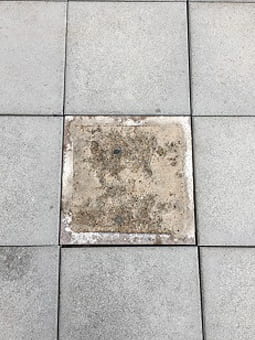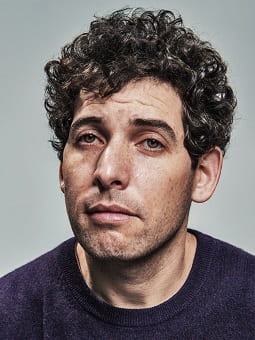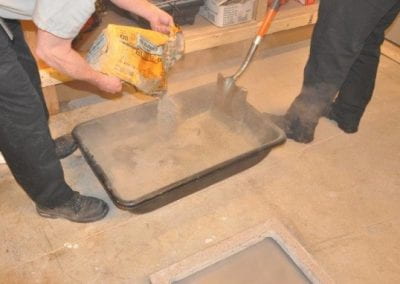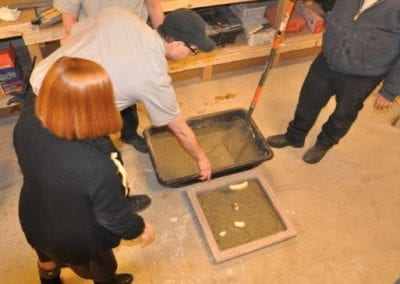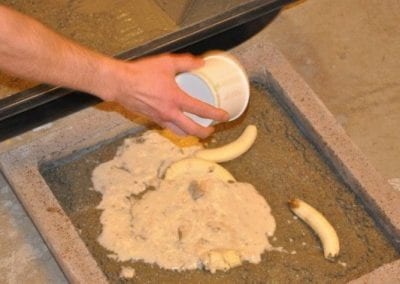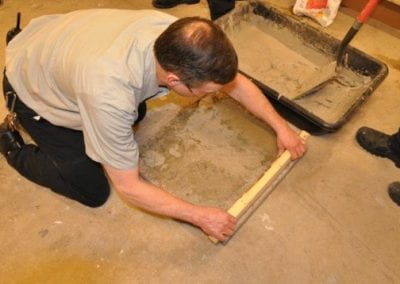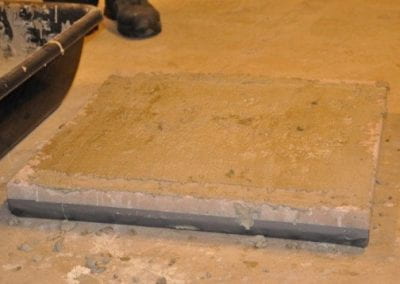For decades, conceptual artists like Darren Bader have been experimenting with art that emphasizes ideas instead of physical objects. In his 1967 essay “Paragraphs on Conceptual Art,” artist Sol LeWitt defines conceptual art as a mode of work in which, “The idea itself, even if it is not made visual, is as much of a work of art as any finished product.” In Pavement Piece #2, Bader utilizes certificate–based production—a mode of working where in the artist writes a verbal description of the artwork rather than producing a visual representation—to contextualize his ideas. Within this dichotomy of ideas and objects, Bader employs the aesthetics of his sculpture—the hidden installation, the alteration of the floor tile pattern, the concealment of materials—to underscore his doubts about the terms of engagement within the contemporary art world. As such, the discourse about these doubts is as much a work of art as the sculpture itself.
Bader has written over one hundred certificate–based works including a vast range of materials: two burritos on a windowsill; three digital images; 16,937 US dollars; a live lion with two ears of corn; a cat made out of crab meat; three pianos and three pianists; a motorcycle on birth control pills; and a pizza with earrings. Pavement Piece #2 is one of Bader’s certificate–based works.
The Booth School of Business at the University of Chicago purchased the certificate for this work from the Sadie Coles Gallery in London, where it was originally offered as part of the artist’s 2013 solo exhibition. Careful consideration of the certificate content reveals transference of power from the artist to the collector. Although Bader provides an additional document, Installation Instructions, which outlines step–by–step instructions for producing the sculpture, the artist delegates several creative choices to the collector, including the overall size and location of the sculpture, the number of bananas, the quantity of clam chowder, the surface finish of the sculpture, the color of concrete—and perhaps most notably—the option to not make the sculpture at all.
Although not every such acquisition results in an art object, the Booth School did choose to produce the sculpture. Carefully following each detail in the instructions, four Facilities staff members at the University produced Pavement Piece #2 and installed it in the Summer Garden. The site of the sculpture physically alters the floor plane. Its raw, uneven, rough surface is a twenty–four by twenty–four inch disruption to the harmony of the grid pattern. Disguised as a flaw in the space, its identity as an artwork is not revealed until, and unless, the viewer questions it. Inquiry is the catalyst necessary to convert the viewer’s perception of this object as a flaw in this space to a work of art.
Investigation of the altered floor tile pattern and the hidden installation site reveal the concealment of materials entombed in the sculpture to the viewer. Knowing bananas and clam chowder are buried within the sculpture prompts the viewer to visualize the entombment. What was obscured is now visible to the viewer—not because they can physically see the bananas and clam chowder in the concrete, but because they can imagine it. The viewer then references their definition of an artwork within more familiar contexts, leading them to question the classification of this object as a work of art. In other words, by physically altering the garden space the sculpture challenges the neutrality of the space and makes the viewer consider the nature and boundaries of art itself.
The very essence of this sculpture is a model for questioning claims made by the contemporary art world regarding what art is. In his essay Open Letter to the Art World, Bader states,
Really, who is kidding who[m]? Obviously we’re kidding a lot of people, ourselves included, who don’t have enough self–confidence to trust that there are lots and lots of naked emperors in the room.
Unlike the emperor in the famous fairy tale by Hans Christian Andersen, who pays a lot of money for new magic clothes that can only be seen by wise people, all the while stubbornly refusing to admit that he himself cannot see the invisible clothes because he does not want to seem stupid, Bader freely admits to doubting the contemporary art world’s terms of engagement.
Pavement Piece #2 achieves the equilibrium Kristine Stiles highlights in her introduction to Theories and Documents of Contemporary Art, “Simultaneously text and object, such a work of art is also an object of theoretical discourse.” When reactions from the public range from viewers who “do not even know it’s there,” who inquire regularly about when the “missing tile will be replaced,” or who “look bewildered” when they learn it is a sculpture with bananas and clam chowder buried within it, that discourse begins to mingle with the object, successfully illustrating Bader’s wariness of contemporary art and making those doubts as much a part of the work of art as the sculpture itself.
Like much of Armitage’s figural sculpture, Diarchy explores the tension between the concepts of single and multiple. The work’s two “head” forms, its breasts, and its legs are placed approximately where one would expect to find them in relation to each other, lending themselves to the interpretation of the sculpture as two figures. However, the size disparities between the limbs, the left figure’s lack of arms, and the compounding of the forms into one mass give the sculpture a numerical ambiguity. The impression of two distinct figures is undermined by the sense that the sculpture’s appendages might have been borrowed from any number of individuals and attached to this monolithic screen. It becomes unclear whether the representation is single, double, or indefinitely multiple. The wall–like screen extends this ambiguity of numbers to an ambiguity of dimensions. This screen divides the work into two sides, subverting the three–dimensional nature of sculpture. Yet it also extends the sculpture’s three–dimensionality by providing a plane from which the figural elements can jut forward into space.
The grassy alcove where Diarchy is sited is a calm space, removed from busy pedestrian thoroughfares and equipped with benches where one might retreat on a nice day. In this context, the sculpture’s seated figures are imbued with a modest presence. They sit quietly, inhabiting the space in the same unobtrusive way other visitors to the alcove might. The work is dwarfed by its surroundings—the glass facade of the D’Angelo Law Library, the stone towers of Burton–Judson Courts, and the gleaming Construction in Space and in the Third and Fourth Dimensions (by far the more prominent piece of public art in the quadrangle). However, it is precisely because it is upstaged that Diarchy is able to operate on a human scale, despite it being slightly larger than life. In a more well–traveled or private context, the sculpture’s static front–facing figures might read as ominous or threatening; but in this tranquil public locale, their stationary activity is not so different from that of any other visitor to the quadrangle. Here, they can simply share the space. Here, they can engage viewers through curiosity instead of confrontation. Diarchy walks the line between figural representation and a strange hybrid memory.
The piece’s outdoor siting does not come without challenges. By 2011, the sculpture’s surface had become corroded from exposure, and its bronze coloring had turned green and brown. The work was taken off–site for conservation in 2013 concurrently with a landscaping revamp of the Laird Bell Quadrangle. During this time, its surface was repaired and its coloration restored to match that of the companion work at the Tate. It was also coated in an Incralac material to help protect it from graffiti and the elements. The sculpture was returned to its original site and placed upon its same granite base, but the patch of grass it once occupied had been transformed into a floral bed. In addition, a new gravel path had been installed, which would be the closest pedestrian walkway to the piece, so the piece was rotated ninety degrees from its original position to face the new path. Positioned in this space of retreat and contemplation, Diarchy offers visitors the chance to contemplate their own cognition and memory.
Written by Jill Ingrassia–Zingales, AM
